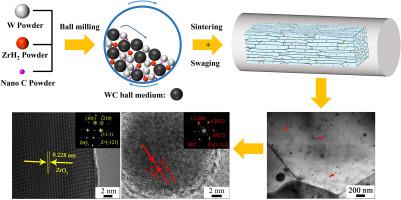International Journal of Refractory Metals & Hard Materials ( IF 3.6 ) Pub Date : 2022-06-02 , DOI: 10.1016/j.ijrmhm.2022.105912 X. Cheng , K. Jing , Z.M. Xie , R. Liu , X.B. Wu , X.P. Wang , Q.F. Fang , C.S. Liu

|
W-Zr-C alloy with nanoscale ZrC particles dispersion was fabricated via powder metallurgy method using W, ZrH2 and nanoscale C powders as starting materials. The average size of in-situ formed particles is 55 nm. The smaller particles in the grain interior are dominantly ZrC particles. Zr decomposed from ZrH2 can also react with impurity oxygen to form ZrO2 particles and reduce the detrimental effects of oxygen on grain boundaries. The as-swaged W-Zr-C alloy is ductile at 200 °C, and the ultimate tensile strength and total elongation (TE) at 300 °C are 643.5 MPa and 23.5%, respectively. After annealing at 1400 °C, the UTS at 300 °C of W-Zr-C alloy is still as high as 611.4 MPa and the TE is 33.2%. The recrystallization start temperature of the as-swaged W-Zr-C alloy is between 1400 and 1500 °C, which is 200 °C higher than that of pure W. The in-situ formation of nanoscale second-phase particles via the dissolution-precipitation mechanism provides a feasible strategy for improving the low-temperature toughness and high-temperature stability of tungsten alloys.
中文翻译:

原位形成ZrC纳米粒子弥散强化钨合金的组织与力学性能
以W、ZrH 2和纳米级C粉末为起始材料,采用粉末冶金法制备了具有纳米级ZrC颗粒分散体的W-Zr-C合金。原位形成的颗粒的平均尺寸为 55 nm。晶粒内部的较小颗粒主要是 ZrC 颗粒。ZrH 2分解的Zr也能与杂质氧反应生成ZrO 2颗粒并减少氧对晶界的不利影响。锻造的 W-Zr-C 合金在 200 °C 下具有延展性,在 300 °C 下的极限抗拉强度和总伸长率 (TE) 分别为 643.5 MPa 和 23.5%。W-Zr-C合金在1400℃退火后,300℃的UTS仍高达611.4 MPa,TE为33.2%。锻造的W-Zr-C合金的再结晶起始温度在1400~1500℃之间,比纯W高200℃。通过溶解原位形成纳米级第二相颗粒-析出机理为提高钨合金的低温韧性和高温稳定性提供了可行的策略。



























 京公网安备 11010802027423号
京公网安备 11010802027423号